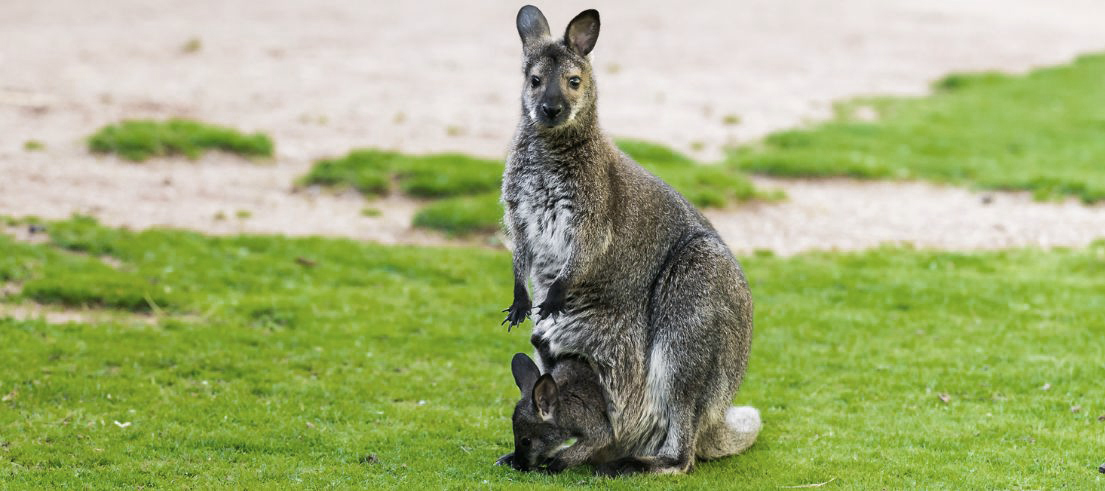Wallabies look like small kangaroos, grow up to 80cm tall, and weigh between 15kg and 25kg. They feed on native forest seedlings, destroy productive farmland, and damage young trees.
Description
- Grey-brown with reddish-brown shoulders and neck, with black-tipped hind feet and tail.
- Leave distinctive tracks, it is unusual for fully formed prints of the whole feet to be left at a site. Creek crossings, bare ground tracks or clay slips are the best places to look.
- Sometimes a tail drag mark can be seen on very soft ground or in snow.
- Their scat (poo) is a good indication if wallabies have been in an area for some time. It is often pelleted and found in clumps, normally coarse in texture with vegetation fibres visible.
- Habitats include edges of dense scrub, pine plantations, native bush and heavy snow tussock where they take refuge during the day and then feed in open areas of grasslands along the margins at night.
- They can be found anywhere below 2000m above sea level.
What you need to know
Selectively browses native forest seedlings, destroys forest understorey and damages young trees in commercial forestry. Destroys productive farmland by competing with livestock for pasture and damaging crops and fences.
For tangata whenua, cultural health, wellbeing, and identity are strongly linked to the physical environment and any impacts are considered holistically together with the impacts on forest health and taonga species.
Management approach
We joined the Biosecurity New Zealand (MPI) led Tipu Mātoro National Wallaby Eradication Programme in July 2020.
The programme is a partnership that includes central and local government agencies, iwi, farmers, landholders and communities.
Together we have a vision for a wallaby-free Aotearoa.
The three work stream priorities within the national programme are:
STOP: Continuing to control breeding populations outside the containment area to locally eradicate wallaby numbers.
SEARCH: Search wider areas outside the containment area to ensure no unknown populations exist.
SEAL: Intensive control within the containment area buffer or fringe areas to reduce continued wallaby spread.
Once we stop the spread of wallabies from the containment area, and eliminate outlier populations, we intend to progressively reduce densities within containment towards the aspirational goal of eradication when such tools arrive.
The Tipu Mātoro Aotearoa New Zealand wallaby strategy sets out the partnership’s proactive plan for protecting New Zealand’s natural and production environments from introduced pest wallabies.
Rules
Responsibility for the planning, coordination and implementation of wallaby control was passed to landowners in 1992, after they voted to disband the South Canterbury Wallaby Board and opt for user-pays pest control.
We produced our first Regional Pest Management Plan in 1996. It outlines a compliance-level requirement of what landholders have opted to maintain within the containment area. The plan requires landholders to control and maintain wallaby numbers on their land at or below Level 3 on the Guilford Scale.
We will carry out inspections within the containment area and, in some cases, may help to coordinate control work between multiple landholders.
Outside of the containment area, we will be responsible for ensuring wallaby populations don’t become established.
Control
It is essential that the wallaby control method you choose is implemented humanely, using best practices and tailored to the level of wallaby present. We've created a guide to help you decide on the best control option for your property, if you'd like us to email one to you please get in touch.
If you see a wallaby outside of Waitaha/Canterbury’s containment area, dead or alive, please report it. If you see signs of wallaby, including footprints or scat (poo), you can report those too. If possible, please take a photo to help us verify the animal and sign.
Reporting signs and sightings means we can investigate the wider area for wallabies and implement control measures if needed.
You can report wallabies online via reportwallabies.nz, or phone Biosecurity Timaru on 03 687 7800 or toll-free on 0800 324 636.
For control and other information visit the National Wallaby Programme page.

